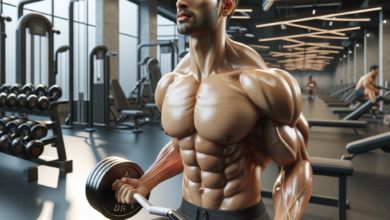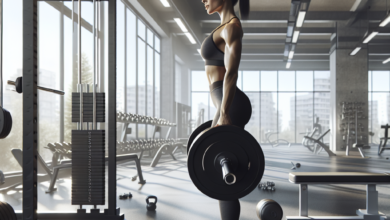Best Workouts for Building Glute Mass

Toned glute muscles may look great, but did you know that your glutes are also crucial for other reasons? Despite the importance of your glute muscles, they are also well-know to be relatively challenging to target during workouts.
In this article, we’ll discuss the importance of glute muscles and give you six workouts that specifically target these muscle groups for maximum strength building and gains.
Why Are Glute Muscles Important?
When you’re looking to gain tone and definition in your butt area, your glute muscles will be your targeted area.
Three main muscle groups make up your buttocks area:
- Gluteus Maximus – This muscle happens to be the largest throughout your entire body. Your hip extension and leg rotation movements are directly reliant on this muscle.
- Gluteus Minimus – The gluteus minimus muscle isn’t the smallest muscle in the whole body, but it is the smallest out of the buttocks muscles. This muscle group helps to rotate your leg inward and away from your body.
- Gluteus Medius – This muscle works similarly to the gluteus minimus in rotating your leg inward and away from the body. The gluteus medius muscle is pork chop-shaped and located in your pelvic area.

Besides supporting essential movement functions, your glute muscles carry other specific benefits that are important both in and out of the gym. Here are some of the most important benefits you can gain from strengthening your glute area:
- Reduction of Injury – By strengthening your glute areas, you can ensure that they can best support their intended functions. This is important because it means other muscles have less chance of being engaged when they otherwise wouldn’t be, thus reducing injury opportunities. Strong glute muscles also help lift extra strain off areas like your back and hips during exercise and general movement.
- Improvement of Posture – Your glutes’ strength directly impacts your posture due to their engagement with your pelvic and hip areas. Through strengthening your glutes, you can help ensure that the body parts that need help are adequately supported.
- Reduction of Back Pain – Your glute muscles are directly involved with your hip, pelvic, torso, and leg muscles; because of this, your glutes can play an essential role in lifting strain off of your lower back.
- Enhanced Athletic Performance – Your glute muscles help to accelerate and decelerate your movement. When you work on strengthening your glutes, improvement in this area can help you enhance your overall athletic performance.

Six Workouts for Building Glute Mass
Glute muscle training is something that should be regularly focused on within your training schedules. If you’re looking for ways to maximize your mass-building efforts in this area, we’ve procured seven workouts below to help:
- Romanian Deadlifts – Your glutes, back, and hamstrings are worked out specifically by doing Romanian deadlifts. To do this exercise, follow these steps:
- Stand straight and grip your barbell using an overhand grip. Hold the bar level to your hips.
- While keeping your back straight and shoulders back, slowly lower the barbell down while keeping it parallel to the floor and pushing your posterior back.
- Return to a standing position to complete the repetition.
- Back Squats – Back squats are excellent for working your glutes and quadricep muscles. To complete this exercise, follow the steps below:
- Lift your weighted barbell from the rack and place it across your shoulder muscles behind your neck.
- Step back from the rack while keeping your feet shoulder-width apart and back straight.
- While keeping the bar in the same position, lower yourself slowly into a position resembling sitting in a chair. Your hips should be just slightly below your knees.
- To complete the rep, slowly raise back up into a standing position.
- Lunges – Lunges not only target your glute muscles, but this exercise is also excellent for strengthening your knee and hip areas. Here’s how you can perform this simple exercise:
- Begin by standing straight with your feet positioned hip-width.
- Step forward with one leg, bend your knee, and lower your other leg’s knee as close as you can to the floor without touching.
- Return to a standing position and repeat this motion with your other leg to complete this repetition.
- Hip Thrusts – Hip thrusts specifically target your glute muscles and are also great for strengthening your hip areas. Here’s how you can perform this exercise:
- You’ll begin this exercise by sitting on the floor in front of a weight bench and with your knees bent.
- Place a weighted barbell across your lap just below your hips.
- Lean up and back to place your shoulders on the bench. While doing this, lift the bar upwards.
- Pause in the lifted position with your knees bent about 90 degrees, and then lower your hips slowly back down to complete the repetition.
- Bulgarian Split Squats – Hip flexion, hip control, and glute muscle building are all benefits of performing Bulgarian split squats. To work this exercise into your workout schedule, perform the following steps:
- Begin by placing one foot onto a knee-height bench.
- Place your body into a lunge position while keeping your back straight and back foot placed firmly on the bench.
- Lower yourself down until your foot and knee are parallel to each other, and your thigh is parallel to the floor.
- Return to the starting position to complete the repetition.
- Front Squats – Front squats are a common and very effective glute exercise. Follow the steps below to ensure this exercise is incorporated into your routine properly:
- Begin by standing straight and gripping a barbell with an overhanded grip.
- Rotate the barbell upwards to just below your chin. Your forearms should be facing upwards and your palms out.
- While keeping your back straight and the bar in place, lower yourself into the squat position with your knees and thighs parallel to the floor.
- Return to the standing position to complete the repetition.
As always, when performing any new exercise, we recommend seeking guidance from a trainer until you’re comfortable with the movements. Your back is an integral part of your body, and you definitely want to take all precautions necessary to avoid injury.



